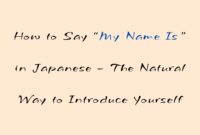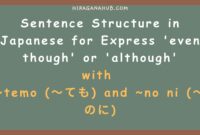Let’s learn Japanese grammar again! This time, we will discuss the grammar
structures “mae ni” (前に), which means “before,” and “ato de” (後で), which
means “after.” First, let’s talk about “mae ni”.
Indicating an Action Done Before Another Action with “~mae ni” (前に)
The word mae (前) generally means “front,” but when used in the context of
time, it means “before.”
The pattern for this grammar is:
(Dictionary form verb) + mae ni (前に) + (Another action)
or
(Noun) + no (の) + mae ni (前に) + (Another action)
Here are some examples to better understand the usage of “mae ni”:
Kanji: 朝ごはんの前にジョギングをします。
Hiragana:
(あさごはんのまえにジョギングをします。)
Romaji: (Asa gohan no mae ni
jogingu o shimasu.)
Meaning: I jog in the morning before breakfast.
Kanji: 宿題をする前にテレビを見た。
Hiragana:
(しゅくだいをするまえにテレビをみた。)
Romaji: (Shukudai o suru mae ni
terebi o mita.)
Meaning: I watched TV before doing my homework.
Kanji: 旅行に行く前に、準備を整えます。
Hiragana:
(りょこうにいくまえに、じゅんびをととのえます。)
Romaji: (Ryokou ni iku
mae ni, junbi o totonoemasu.)
Meaning: Before going on a trip, I prepare
everything.
Kanji: 私は三年前にその本を読みました。
Hiragana:
(わたしはさんねんまえにそのほんをよみました。)
Romaji: (Watashi wa
san-nen mae ni sono hon o yomimashita.)
Meaning: I read that book three
years ago.
Indicating an Action Done After Another Action (After / 後で / ato de)
The opposite of “mae ni” is “ato de” (後で), which means “after.”
Additionally, the kanji ato also has other meanings, such as “behind” (ushiro)
or “the future” (go ni), depending on the context.
The pattern for this grammar is as follows:
(Past tense verb) + Ato de (後で) + (Another action)
or
(Noun) + Ato de (後で) + (Another action)
Here are some examples of using “ato de”:
Kanji: ランチの後で散歩をします。
Hiragana:
(ランチのあとでさんぽをします。)
Romaji: (Ranchi no ato de sanpo o
shimasu.)
Meaning: I will take a walk after lunch.
Kanji: 昨日映画を見た後で、カフェに行きました。
Hiragana:
(きのうえいがをみたあとで、カフェにいきました。)
Romaji: (Kinou eiga o
mita ato de, kafe ni ikimashita.)
Meaning: After watching a movie
yesterday, I went to a café.
Kanji: 会議の後でお茶を飲みましょう。
Hiragana:
(かいぎのあとでおちゃをのみましょう。)
Romaji: (Kaigi no ato de ocha o
nomimashou.)
Meaning: Let’s have tea after the meeting.
Kanji: 学校から帰ってから、友達と会います。
Hiragana:
(がっこうからかえってから、ともだちとあいます。)
Romaji: (Gakkou kara
kaette kara, tomodachi to aimasu.)
Meaning: After I get home from school,
I will meet my friend.
Using “ato de” to Indicate a Future Time
When “ato de” is used to indicate future time, the expression “go ni” (後に)
can also be used, meaning “in the future” or “later.” Here are examples:
Kanji: 二ヶ月後にプロジェクトを終わらせます。
Hiragana:
(にかげつごにプロジェクトをおわらせます。)
Romaji: (Nikagetsu go ni
purojekuto o owarasemasu.)
Meaning: I will finish the project in two
months.
Kanji: その問題は後で解決します。
Hiragana:
(そのもんだいはあとでかいけつします。)
Romaji: (Sono mondai wa ato de
kaiketsu shimasu.)
Meaning: I will solve the problem later.
Kanji: 山の後ろに小屋があります。
Hiragana:
(やまのうしろにこやがあります。)
Romaji: (Yama no ushiro ni koya ga
arimasu.)
Meaning: There is a cabin behind the mountain.
Conclusion
In summary, “mae ni” (前に) is used to indicate that something happens before
another activity, while “ato de” (後で) is used to indicate something that
happens after another activity. Additionally, mae can also mean “the past”
when referring to a specific time, and ato has multiple meanings depending on
the context, such as “behind” (ushiro) or “future” (go ni).
I hope this explanation makes it easier to understand how to use “mae ni” and
“ato de” in Japanese! If you have any questions, feel free to ask!



